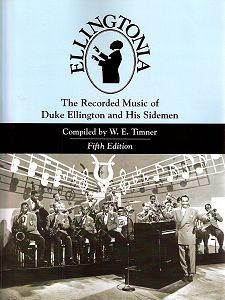Sometimes dreams come
true. For years I have yearned to have a complete
discography of Duke Ellington's recordings,
and had to struggle along with the outline
listing in Peter Gammond's nevertheless worthwhile
Duke Ellington (1987) and other partial
discographies. So, encountering this marvellous
book for the first time, I felt I like some
watcher of the skies when a new planet swims
into his ken (or something like that). Mr
Timner doesn't call it a discography but he
has compiled a reference book which comprehensively
covers not only the recordings of Duke Ellington
but also those that his musicians made under
their own names or with other bands while
they were with Ellington. This even includes
musicians (like Cootie Williams and Lawrence
Brown) who left the Duke's orchestra for a
while before rejoining it - because, as Mr
Timner says, they have always been "True Blue
Ellingtonians".
Having such a guide to Ellington's
recordings is particularly important because,
as Dan Morgenstern says in his Editor's Foreword:
"Some very knowledgeable people call [Ellington]
the greatest of American composers". Not only
that: I believe that the Duke was the greatest
composer/arranger in jazz and therefore of
prime importance in the history of the music.
The huge scope of the book
is understandable, because Ellington led his
own ensembles for 50 years: from the Washingtonians
in 1924 to his death in 1974. Not only that,
but he was a prolific composer and arranger
who recorded many of his compositions over
and over again - often in new versions or
with different titles. For instance, the book
tells us that Under the Balcony was
also recorded as Sonata and Balcony
Serenade. Never No Lament was also
known as Foxy, Zoom-Ha-Ka and Zoom-Ha-Laa.
This tune is one of many Ellington compositions
that had lyrics added to them later, so that
Never No Lament became Don't Get
Around Much Any More, while Concerto
for Cootie was turned into Do Nothing
'til You Hear From Me.
This discography was clearly
a labour of love but understandably an immense
labour, entailing a massive amount of research.
It has resulted in a work of scholarship which
seldom puts a foot wrong. In fact, its standard
is so high that the reader is surprised to
find the occasional mistake - like the tune
listed in the index as Didicated (sic)
To You, with a recording date given
as 19 April 1950 - a date when Ellington apparently
made no recordings.
The book came in useful almost
as soon as I received it. The tune Angelica
sounded familiar when I heard it on a 1962
recording. The discography reminded me that
I knew it better as Purple Gazelle
from the underrated 1963 album Afro-Bossa.
Apparently the tune also appeared under the
titles of Angelique, Cali and Ragtime
Cha Cha.
The book has several sections.
Besides the main chronological list of the
Ellington Orchestra's recording sessions,
there is the separate list of the recordings
made by Ellington alumni. From this one can
trace such facts as Johnny Hodges playing
for groups led by Woody Herman, Earl Hines,
Billy Taylor and Sandy Williams, as well as
the better-known sessions with Teddy Wilson
and Lionel Hampton, plus numerous recordings
leading his own groups.
There is also a list of radio
and TV broadcasts as well as a general index,
and indexes of musicians, plus cities and
venues. A three-page Addenda emphasises
how knowledge continues to multiply, even
about a musician who died more than a generation
ago. The music lives on - and so does our
interest in it, which is where books like
this are invaluable. I cannot recommend this
wonderful book too highly to anyone who loves
Ellington's music - and that should surely
include all jazz fans.
Tony Augarde
